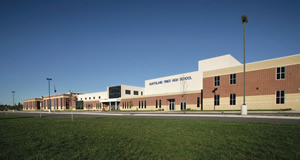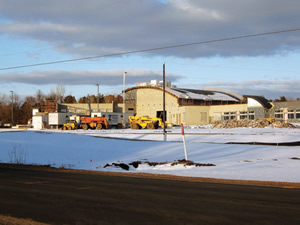The Building You Want... Within the Budget You Have!

PHOTOS COURTESY OF HOFFMAN PLANNING, DESIGN & CONSTRUCTION, INC.
Planning Ahead. The decision at Northland Pines High School in Eagle River, Wis., to use a smaller chiller offered an initial cost savings. This savings allowed the district to include in the design additional items that were previously desired but unaffordable. The decision was made with the help of an integrated project team — comprised of school district personnel, designers, engineers, construction professionals and expert consultants — who brought a holistic approach to the project and helped ensure that the design was budget conscientious while meeting or exceeding quality and performance expectations. Another factor to consider is that a new school’s construction schedule, which can be heavily influenced by the climate in the project’s geographic location, can have a significant impact on construction costs.
Once the budget has been established for your school construction project, staying within it does not have to be a constant process of sacrifice and compromise. Clearly identifying and documenting the scope of work for each aspect of the project in the early stages is vital. This will have a significant impact on keeping your design and construction professionals on the trajectory of being on time and under budget. Follow these 10 steps throughout the project process to ensure that your project soars — but its costs don’t!
1. Deal with desires — It’s common for a successful referendum to lead to numerous appeals for programs that were not identified prior to the referendum. Administrators and staff may get the impression the district now has millions of discretionary dollars. A vision or goals for your project should be established early in the design process, and your team should evaluate and filter requests carefully based on how well they match your goals or achieve your vision. Specifically with schools, these requests need to be challenged to see how well they align with a vision for a 21st-Century education. For example, if your district is working towards 1:1 technology access, are fixed computers in a lab still necessary? Be certain to use the opportunity to clarify the direction and vision for the school as you evaluate the requests to determine the merit.
2. Contemplate constructability — Square footage isn’t the only driver in determining costs, but it is a major contributing factor and a common standard. Be certain to contemplate the constructability of that square footage as this can provide an opportunity for cost savings. The time it takes to construct your project goes hand in hand with constructability; therefore, time will also influence your budget. In one instance, changing the structural framing system of a school dramatically reduced the amount of steel required — reducing the cost without compromising the integrity of the building in the least. The cost reduction outweighed the additional time required to construct the structure.
3. Value Trading — Value Trading is the art of making design choices that provide greater value and “paying” for those by changing or eliminating design features and elements that provide less benefit. This collaborative process can keep costs within budget, while improving the design and performance of a building. The HVAC system at Northland Pines High School in Eagle River, Wis., provides a great example. Energy modeling revealed that the suggested chiller might be larger than necessary. It was determined that the larger chiller would be used only in extremely infrequent and unlikely circumstances. Additionally, analyses confirmed that the temperature might drift up a mere two degrees above an optimum temperature of 75 degrees in those infrequent situations. We recommended a smaller chiller that would provide initial cost savings and limit future demand charges from the utility provider. Value Trading allowed the school district to invest in other, more valuable items, that they would not otherwise have been able to afford.
4. Discuss deviations — It’s important to consistently track any deviations to the scope of the design and regularly discuss both the short and long-term cost consequences. You can then determine what adjustments should be made to allow for any cost increases.
5. Consider the finishes — Finishes (interior and exterior) can have a substantial influence on both initial costs and ongoing maintenance budgets and should be thoroughly discussed and evaluated to maximize the value of each choice. The project team for Woodland School in Kimberly, Wis., made a discovery that resulted in a 40 percent reduction in brick costs. During the design stage, the project team found a viable alternative to the conventional clay brick in a local concrete brick product. There were multiple benefits, including sizable cost savings, with no effect on appearance. These are the kinds of creative decisions that impact value, cost and satisfaction.

PHOTOS COURTESY OF HOFFMAN PLANNING, DESIGN & CONSTRUCTION, INC.
6. Team up for savings — Sub-contractors who regularly bid, install and service equipment can often offer valuable advice on cost savings. Mechanical, plumbing and electrical engineers may be unaware that the cost of specified systems and fixtures might be much higher than equally effective alternatives. By taking advantage of a multi-disciplinary team — consisting of construction, engineering and design professionals alongside expert consultants — you’ll benefit from everyone being responsible and coordinating a unified approach to ensure that the design is cost-effective while meeting or exceeding quality and performance expectations.
7. Be aware of future needs — Be careful not to eliminate imperative items that can’t be added later. Rather, create a base project with alternate bids to enhance space, finishes, and added scope items. Alternate bids should consist of a list of items whose scope is clearly defined through drawings and/or specifications that are not included in the base project. Pricing is obtained at the time of bidding to ensure that it is as competitive as possible. In the event that the base project comes in under budget, some of the alternate items can be selected for inclusion. This is a more cost-effective approach than eliminating an option that will be impossible or cost prohibitive to add later. For example, it would be wise and less expensive to “shell out” future rooms (installing floors, walls, and roof) rather than constructing completed classrooms if you feel that it is likely you’ll need to add educational space in the near future. Programming needs may change and those may impact the physical layout of the rooms and the needs for electrical, ventilation, and other system requirements. Identifying future needs also allows for features and additions to be made to your school in the future after a building is completed.
8. Compare costs to budget — Ongoing monitoring of costs and comparing actual expenses to the original budget is vital and should include site design, selections of materials and systems, and constructability. As the building design becomes more defined, the initial cost estimates in the conceptual and schematic design phases are replaced by more detailed quantity estimates of materials and systems. Obtaining up-to-date materials pricing from subcontractors is crucial during the design phase.
9. Be mindful of seasonal timing — The construction timing as it relates to seasons can sometimes have an immense impact on construction costs. Winter weather and rainy seasons can make a sizable difference. Ideally, the majority of the exterior work should be carried out and the building fully enclosed before inclement weather impacts project schedules. Unexpected delays can be costly. Avoid paying a premium for challenges caused by adverse weather conditions. It is wise to establish a timeline for completing the design drawings and specifications and then work backwards to decide if a spring, fall or special election referendum will make it possible for the ground to be broken in sufficient time. In addition, bidding a project in the winter months often results in more competitive bids as subcontractors are trying to prepare for the coming spring and summer. Long lead times for certain items, such as steel, custom fixtures or equipment, should also be considered to eliminate paying a premium to have them expedited or to avoid costly delays to the schedule.
10. Stay on target — An experienced estimator should work closely with the entire design team and enable adjustments to keep the design near the center of the targeted budget. If bids come in over budget, avoid haphazardly cutting project scope to keep the project in budget. This can result in compromising on function, aesthetics and/or operations.
By following these steps you’ll have a sound strategy for getting the most for your students, staying within your budget and delivering a school construction project that builds trust in your community!
This article originally appeared in the March 2015 issue of School Planning & Management.